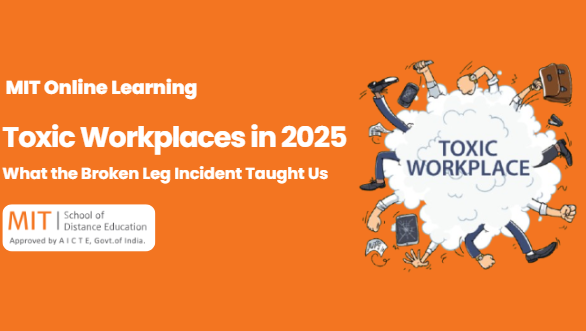
In an age of heightened workplace awareness and mental health advocacy, 2025 has seen a growing intolerance for toxic work environments. But occasionally, a story breaks through the noise to remind us just how deeply ingrained these issues still are.
One such incident recently went viral: a manager allegedly asked an employee with a broken leg to return to work or risk losing their job. The employee, in turn, resigned, sparking widespread debate and outrage online. Beyond the headlines, this story has become a case study in toxic work culture, poor leadership, and HR policy failure. It raises critical questions: How much is too much? Where do we draw the line between professional expectations and basic human decency?
Let’s explore what this incident revealed about toxic workplaces in 2025 and how HR professionals can step in to protect employee well-being.
The Broken Leg That Broke the Internet
According to a report by The Economic Times, an employee decided to resign after their manager allegedly insisted they return to work while recovering from a broken leg. The demand was met with disbelief and condemnation across social media platforms. The employee’s story—shared on Reddit—quickly gained traction and sparked a fierce debate about the state of workplace empathy and how far toxic cultures can go to prioritize productivity over people.
This conversation quickly ignited social media. Hashtags like #ToxicWorkplace and #EmployeesAreHuman started trending, while thousands of users weighed in with their personal experiences, emotional reactions, and professional opinions.
It wasn’t just a case of poor communication—it was emblematic of a culture that prioritizes output over people, compliance over compassion.
What This Incident Teaches Us About Toxic Workplaces
The broken leg incident wasn’t an isolated event; it was a symptom of a systemic disease that persists across industries and geographies. Here are a few lessons it highlighted:

1. Lack of Empathy from Leadership
When leaders view employees as tools rather than people, empathy is the first casualty. This mindset promotes fear, burnout, and resentment among employees. Compassion and flexibility—especially in health-related cases—are non-negotiable in any humane work environment.
2. Inadequate HR Intervention
A strong Human Resources (HR) department should act as the bridge between employee welfare and organizational goals. The absence or inefficacy of HR intervention in such cases points to a failure in policies and escalation mechanisms.
3. Unhealthy “Hustle Culture”
The insistence on working through injury stems from the toxic glorification of overwork. This culture undermines physical and mental well-being, contributing to stress, disengagement, and attrition.
4. Fear-Driven Performance
Employees who are afraid to speak up or take necessary medical leave are often operating under fear-driven leadership. Such workplaces see higher turnover rates and lower morale, proving that fear is a poor motivator in the long run.
5. Legal and Ethical Oversight
In many jurisdictions, forcing an employee to work while injured can be a violation of labor laws. It also poses ethical concerns, making organizations vulnerable to lawsuits and public backlash.
The Psychological Cost of Toxic Work Environments
Research in 2025 continues to show a strong correlation between toxic workplaces and mental health disorders. Employees working under high-stress, low-empathy environments are more prone to:
- Anxiety and depression
- Emotional exhaustion
- Poor sleep and health habits
- Declining job satisfaction
- Workplace alienation
The broken leg incident is just one trigger; the underlying damage unfolds slowly and often invisibly.
How HR Professionals Can Prevent Toxicity
The role of HR has never been more critical. As gatekeepers of workplace culture, HR professionals need to adopt a people-first strategy. Here’s how:
✅ Establish Clear Leave and Wellness Policies
Well-documented leave policies, especially those covering health emergencies, must be communicated and upheld by management.
✅ Train Leaders in Empathy and Communication
Organizations should invest in leadership training focused on emotional intelligence and inclusive communication.
✅ Create Safe Escalation Channels
Employees must feel safe reporting toxic behavior without fear of retaliation. Anonymous reporting tools, open-door policies, and whistleblower protection are essential.
✅ Enforce Accountability
Whether it’s a senior leader or a junior manager, toxic behavior must carry consequences. HR must enforce discipline based on unbiased investigations.
✅ Prioritize Mental Health
Offering mental health resources, counseling support, and regular employee well-being check-ins should become the norm rather than the exception.
Building the Future: HR Education in 2025
Today’s HR professionals must be equipped not only with theoretical knowledge but also practical tools to shape inclusive and sustainable workplaces. This is where educational institutions like the MIT School of Distance Education (MITSDE) play a transformative role.
Whether you’re a working professional or a graduate aiming to build a career in human resources, MITSDE’s HR programs are designed to meet the complex demands of the modern workplace.
🎓 Courses Offered by MITSDE in Human Resources:
- PGDM Executive in Human Capital Management
Ideal for senior professionals, this program focuses on strategic leadership, workforce planning, and culture management. - PGDM Human Resource Management
A comprehensive 2-year course covering recruitment, training, labor laws, and organizational behavior—perfect for mid-career HR aspirants. - PGDBA Human Resource Management
A business-oriented HR program offering a blend of managerial insight and human resource strategies for cross-functional growth. - Professional Certification in Human Resource Management
A short-term, focused program crafted for those looking to specialize or upskill in core HR areas.
These programs align with industry expectations, promote ethical leadership, and integrate real-world case studies—including incidents like the broken leg controversy—to prepare students for crisis resolution and cultural transformation.
Why Choose MITSDE for HR Education?
✅ Best Distance PGDM HR Courses
✅ Industry-Ready Curriculum
✅ Recognition & Accreditation
✅ Career Support & Networking
Final Thoughts: A Wake-Up Call for Workplaces
The broken leg incident was more than just a viral headline. It was a mirror to thousands of workplaces that continue to ignore the human behind the job title. If organizations are to thrive in 2025 and beyond, they must replace toxicity with trust, rigidity with empathy, and exploitation with empowerment.
The future of work belongs to organizations that care, and to HR professionals who have the vision and training to make that care operational.
If you’re inspired to be part of this much-needed change, now is the time to invest in your HR career.
Let this story be a lesson—and let your career in HR be part of the solution.



